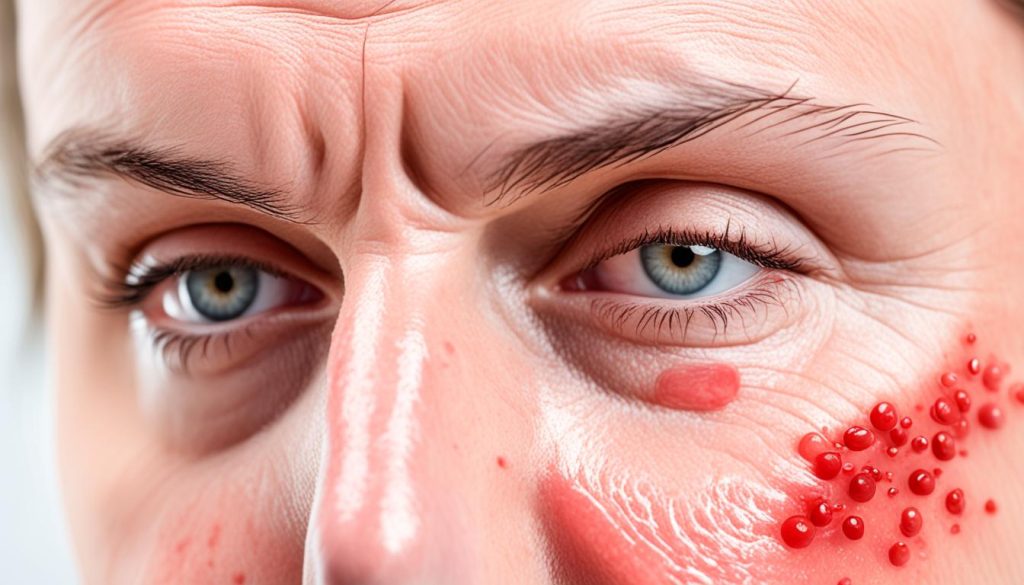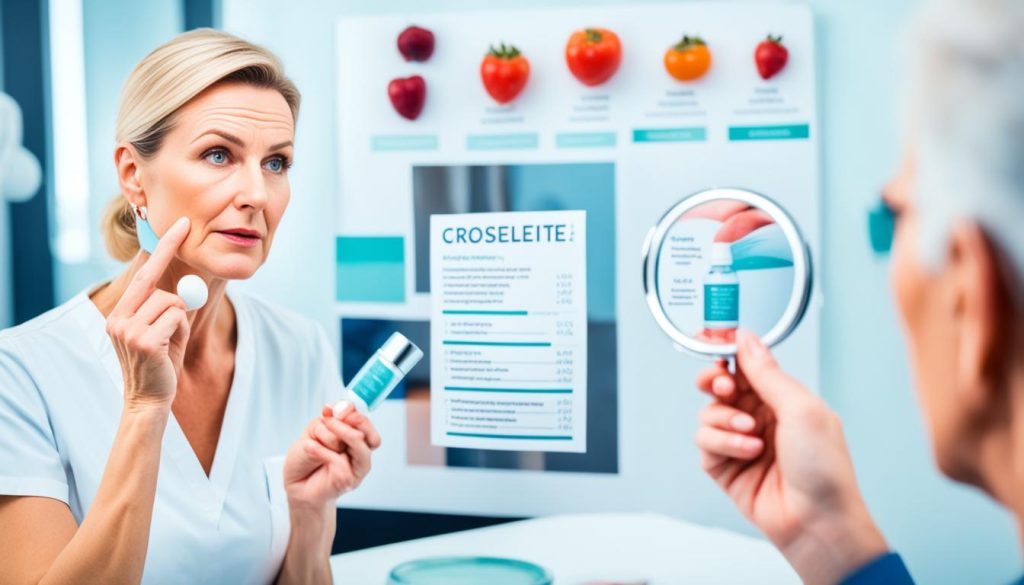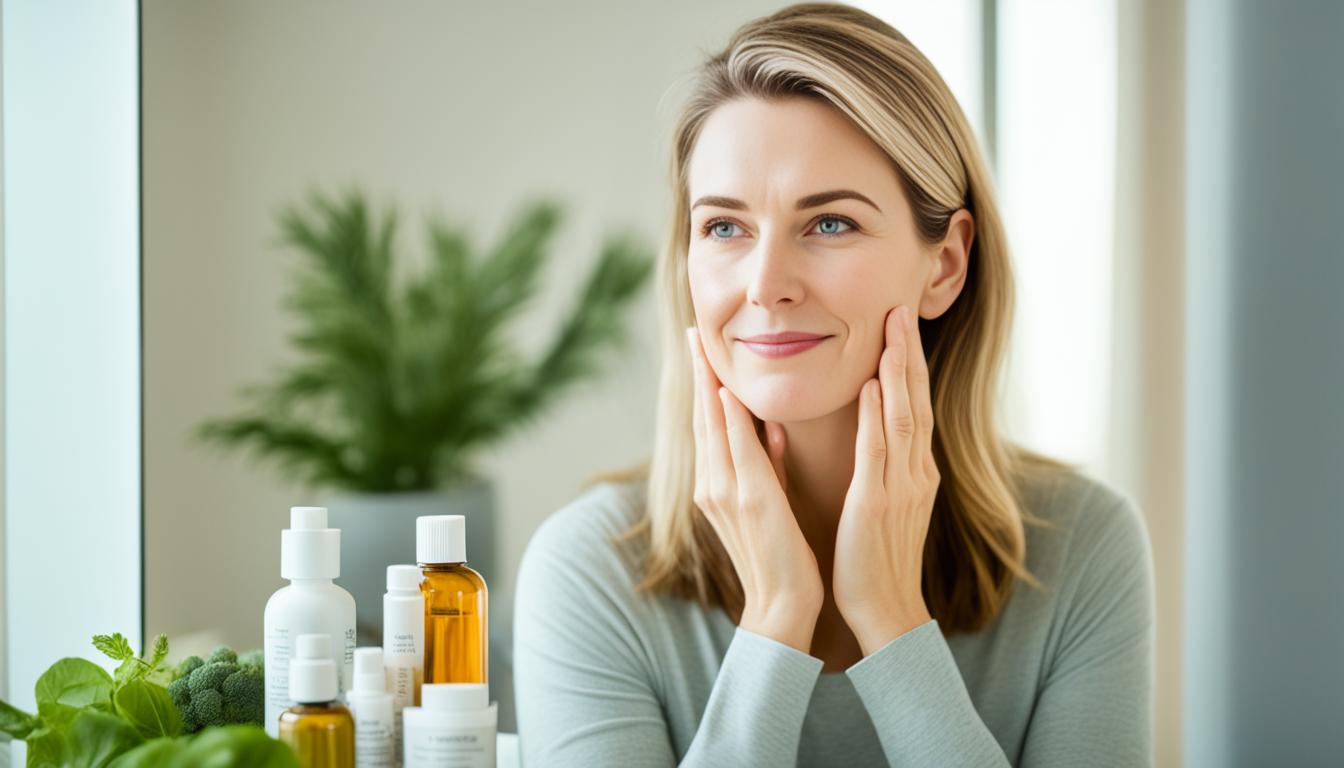Rosacea is a common chronic skin condition that causes redness, inflammation, and sometimes pimples on the face. While there is no cure for rosacea, there are various treatment options available to help reduce the symptoms. In this article, we will discuss different treatment methods, lifestyle changes, and skincare tips that can help manage and minimize rosacea flare-ups.
What is Rosacea and its Symptoms?
Rosacea is a chronic skin condition that primarily affects the face, causing redness, inflammation, and the development of pimples. It is more common in women than men and typically affects adults over the age of 30. The exact cause of rosacea is unknown, but possible factors include genetic and environmental factors.
The main symptoms of rosacea include:
- Persistent redness on the cheeks, nose, chin, or forehead
- Visible blood vessels on the face
- Swelling or inflammation of the eyelids
- Eye irritation and redness
- Dry and flaky skin
- Thickening of the skin
The Main Cause of Rosacea
The main cause of rosacea is yet to be determined, but research suggests a combination of genetic and environmental factors may contribute to its development. Genetic predisposition, abnormalities in facial blood vessels, immune system dysfunction, and the presence of certain bacteria on the skin are some of the factors that may play a role in the development of rosacea.

How to Get Rid of Rosacea Permanently?
Diagnosing and Treatment Options for Rosacea
Rosacea, a chronic skin condition characterized by redness, inflammation, and pimples on the face, is typically diagnosed by a dermatologist or medical professional through a thorough medical history assessment and physical examination of the skin. During the assessment, the dermatologist will inquire about the patient’s symptoms, their medical history, and any triggers that may worsen the condition. The physical examination focuses on identifying specific signs of rosacea, such as persistent redness, visible blood vessels, and skin thickening. By understanding the patient’s medical background and assessing the physical symptoms, a dermatologist can make an accurate diagnosis.
While there is no cure for rosacea, several treatment options can help manage and reduce its symptoms. Dermatologists recommend a combination of strategies based on the severity of the condition and individual patient needs. Among the commonly prescribed treatment methods are topical medications, including metronidazole, erythromycin, and azelaic acid, which can be applied directly to the affected areas on the skin to alleviate redness and inflammation. Additionally, oral medications such as doxycycline and erythromycin may be prescribed for their anti-inflammatory properties, especially for more severe cases.
In some instances, dermatologists may opt for laser and light therapy, which can target and reduce visible blood vessels, redness, and inflammation. This treatment involves the use of specific wavelengths of light that are absorbed by the blood vessels, causing them to shrink and fade over time. Dermabrasion, another treatment option, involves the removal of the top layer of skin using a rotating brush or diamond wheel to reduce thickening and improve the texture of the treated area.
In certain cases, electrocautery, a procedure that uses heat or electrical energy to remove visible blood vessels, or surgery may be utilized to address severe symptoms of rosacea. These treatment options should be discussed thoroughly with a dermatologist, as they carry their own risks and benefits and may not be suitable for every individual with rosacea.

| Treatment Options | Description |
|---|---|
| Topical medications | Medications applied directly to the skin, such as metronidazole, erythromycin, and azelaic acid, helping alleviate redness and inflammation |
| Oral medications | Prescribed anti-inflammatory medications, like doxycycline and erythromycin, taken orally for more severe cases of rosacea |
| Laser and light therapy | Non-invasive treatment using specific wavelengths of light to target and reduce visible blood vessels, redness, and inflammation |
| Dermabrasion | Procedure involving the removal of the top layer of skin to reduce thickening and improve texture |
| Electrocautery | Procedure utilizing heat or electrical energy to remove visible blood vessels |
| Surgery | In severe cases, surgical interventions may be necessary to alleviate symptoms |
Lifestyle Changes for Rosacea Relief
Making certain lifestyle changes can significantly help relieve symptoms and minimize flare-ups of rosacea. By incorporating these changes into your daily routine, you can better manage your rosacea symptoms and maintain clear skin.
Identify and Avoid Triggers
One of the key strategies for rosacea relief is identifying and avoiding triggers that can aggravate your symptoms. Some common triggers to avoid include:
- Sun exposure: Protect your skin from harmful UV rays by wearing sunscreen with a minimum SPF 30 and a wide-brimmed hat.
- Stress: Practice stress management techniques such as deep breathing, meditation, or engaging in relaxing activities.
- Hot weather: Stay cool during hot weather by seeking shade, using fans, or air conditioning.
- Spicy foods: Limit your consumption of spicy foods, as they can trigger flushing and inflammation.
- Hot drinks: Opt for cooler or room temperature beverages instead of hot drinks that can cause facial flushing.
Skincare Products and Moisturizing
Using the right skincare products and moisturizing regularly can also play a crucial role in rosacea relief. Consider the following tips:
- Choose gentle skincare products specifically designed for sensitive skin. Look for products that are fragrance-free and hypoallergenic.
- Avoid harsh exfoliants and cleansers that can irritate your skin. Opt for mild, non-abrasive products.
- Moisturize your skin daily to maintain hydration and protect against dryness. Choose hydrating moisturizers that are non-comedogenic and suitable for sensitive skin.
By following these lifestyle changes, you can help reduce the frequency and severity of rosacea flare-ups, allowing you to enjoy clearer and calmer skin.

| Trigger | Impact on Rosacea |
|---|---|
| Sun exposure | Can cause redness and inflammation |
| Stress | May trigger flushing and worsen symptoms |
| Hot weather | Can lead to facial flushing and increased redness |
| Spicy foods | May cause flushing and irritation |
| Hot drinks | Can trigger facial redness and inflammation |
Natural Remedies and Skincare Tips for Rosacea
In addition to medical treatments, incorporating natural remedies and following a gentle skincare routine can help alleviate symptoms of rosacea. These simple yet effective strategies aim to soothe the skin, calm redness, and minimize flare-ups. Here are some tips to consider:
1. Harness the Power of Natural Ingredients
Utilize the healing properties of natural ingredients such as aloe vera, green tea, and chamomile. Aloe vera gel can help soothe irritated skin and reduce redness, while green tea and chamomile have anti-inflammatory properties that can calm skin sensitivity.
2. Opt for Gentle Skincare Products
Choosing skincare products specifically formulated for rosacea-prone skin is crucial. Look for gentle cleansers that won’t strip the skin’s natural moisture barrier and soothing moisturizers that provide hydration without causing irritation.
3. Embrace Anti-Inflammatory Ingredients
Include skincare products containing anti-inflammatory ingredients like niacinamide in your routine. Niacinamide can help reduce redness and inflammation associated with rosacea, promoting a calmer complexion.
4. Avoid Harsh Cleansers and Exfoliants
Steer clear of harsh cleansers and exfoliants that can aggravate sensitive skin. Opt for mild, fragrance-free cleansers and avoid physical exfoliants to prevent further irritation.
5. Mineral-Based and Non-Comedogenic Makeup
When choosing makeup, opt for mineral-based or non-comedogenic products that won’t clog pores or exacerbate rosacea symptoms. Avoid heavy makeup that can further irritate the skin and opt for lightweight formulas that provide coverage without causing flare-ups.
6. Practice Sun Protection Habits
Protecting your skin from the sun is crucial for rosacea management. Always wear sunscreen with a minimum SPF of 30 and seek shade during peak sun hours. Additionally, wearing a wide-brimmed hat and sunglasses can provide extra protection against harmful UV rays.
It’s important to note that while natural remedies can be helpful, it’s essential to consult with a dermatologist before trying any new treatments. They can provide personalized recommendations and ensure that the chosen remedies align with your skin’s specific needs.
By incorporating these natural remedies and adopting a gentle skincare routine, you can help calm rosacea redness and maintain a healthier, more balanced complexion.
| Skincare Tips for Rosacea | Natural Remedies for Rosacea |
|---|---|
| Opt for gentle skincare products | Utilize natural ingredients like aloe vera, green tea, and chamomile |
| Use anti-inflammatory ingredients like niacinamide | Avoid harsh cleansers and exfoliants |
| Choose mineral-based or non-comedogenic makeup | Practice sun protection habits |
Tips for Long-Term Rosacea Control
While there is no permanent cure for rosacea, there are measures you can take to achieve long-term control. By following a consistent skincare routine, staying vigilant with triggers, managing stress levels, maintaining a healthy lifestyle, and regularly visiting a dermatologist, you can effectively reduce rosacea flare-ups and maintain clear, healthy skin in the long run.
1. Follow a Consistent Skincare Routine
Developing a skincare routine tailored to your rosacea can help minimize symptoms and reduce flare-ups. Opt for gentle cleansers and moisturizers specifically formulated for sensitive skin. Avoid harsh chemical-based products that may irritate your skin. Additionally, ensure that you moisturize regularly to keep your skin hydrated and protected.
2. Stay Vigilant with Triggers
Identifying and avoiding triggers is essential for long-term rosacea control. Common triggers include sun exposure, hot weather, spicy foods, hot drinks, and certain skincare products. Be mindful of these triggers and take necessary precautions to minimize their impact on your skin. Using sunscreen with at least SPF 30 can provide added protection against harmful UV rays.
3. Manage Stress Levels
Stress can exacerbate rosacea symptoms, leading to increased flare-ups. Implement stress-management techniques such as meditation, deep breathing exercises, and engaging in relaxing activities to help reduce stress levels. Prioritize self-care and make time for activities that promote relaxation and overall well-being.
4. Maintain a Healthy Lifestyle
Avoiding excessive alcohol consumption and quitting smoking can significantly improve rosacea symptoms. Additionally, adopting a balanced diet rich in fruits, vegetables, and antioxidants can support overall skin health. Regular exercise, such as yoga or low-impact activities, can also help reduce stress levels and improve blood circulation.
5. Regularly Visit a Dermatologist
A dermatologist is an invaluable resource when it comes to managing rosacea. Regular check-ups allow your dermatologist to monitor your condition, adjust treatment plans as needed, and provide guidance on the best skincare products and treatments for your specific needs. Working closely with a dermatologist ensures you receive the most up-to-date and effective care for long-term rosacea control.
By incorporating these tips into your daily routine, you can significantly reduce rosacea flare-ups and maintain clear, healthy skin in the long term. Remember to be patient and consistent with your skincare and treatment regimen, as it may take time to see significant improvements. With the right approach, you can achieve long-term control and live comfortably with rosacea.

Conclusion
Managing rosacea symptoms and living with rosacea can be challenging, but with the right approach, it is possible to effectively control the condition and minimize its impact on your daily life. By working closely with a dermatologist and developing a personalized treatment plan, you can address your specific needs and ensure the best possible outcome. Staying informed about new research and advancements in rosacea management is also crucial for staying ahead in your journey.
Remember, you are not alone in this fight. Support organizations and resources are available to provide you with the information, guidance, and emotional support you need. Connecting with others who are also living with rosacea can be particularly helpful, as they understand the unique challenges you face. Together, you can share experiences and strategies for managing symptoms and enhancing your quality of life.
With proper care, commitment, and a strong support system, you can lead a fulfilling life while living with rosacea. So don’t let rosacea define you. Take control of your condition, prioritize self-care, and embrace the journey towards managing your rosacea symptoms effectively.

